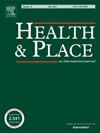西班牙裔社区健康研究/拉丁裔青少年研究辅助研究(SOL Youth)中儿童照顾者的家庭食品安全状况、感知邻里食品环境和食品购物行为特征
IF 3.8
2区 医学
Q1 PUBLIC, ENVIRONMENTAL & OCCUPATIONAL HEALTH
引用次数: 0
摘要
美国西班牙裔/拉丁裔家庭的粮食不安全程度不成比例,这可能与他们的食品环境和食品购物行为相交叉,从而影响他们的饮食和健康,但需要更多具有代表性的研究结果。我们确定了美国西班牙裔/拉丁裔家庭中与家庭食品安全(HFS)、食品环境和食品购物行为相关的潜在类别,并调查了它们与社会人口统计学特征的关系。我们使用了983名与青少年(8-16岁)一起居住的成人看护者的横断面数据,并参与了拉丁裔青年的多地点研究。照顾者完成了USDA HFS调查模块(高、边际、低、极低FS)、5项感知社区食品环境(健康食品可得性、质量、成本)问卷和5项食品店购物频率问卷。我们通过检查标准拟合标准确定了潜在类别的最佳拟合解决方案,并确定了潜在类别与远端社会人口学特征的关系。我们确定了一个5类解决方案。“一般质量,稍贵的食品环境”类别(19.7%)有低和高HFS,并在各种食品店购物;这门课的参与者中,外国出生的比例最高(96%),西班牙语是他们的首选语言(90%)。“高品质、高成本的食物环境、食物不安全的家庭”类别(22.6%)在超市购物,家庭收入≤20,000美元的受访者比例最高(68%)。“质量差、成本高的食品环境”类别(16.8%)的HFS分别为低和高,并在超市和便利店购物;这个班的参与者中,单身(33%)、无车(53%)、以英语为首选语言(39%)的比例最高。“高品质,稍贵的食物环境,食物安全的家庭”类别(15.0%)在各种食品店购物,家庭收入为20,000美元的参与者所占比例最高(65%)。“高质量、可负担的食品环境、食品安全家庭”阶层(25.9%)在超市购物,在美国出生的参与者比例最高(25%)。与青少年一起生活的美国西班牙裔/拉丁裔成年人报告了HFS状况、感知到的社区食物环境和食物购物行为的不同组合,这强调了定义充足食物获取的因素的复杂性。本文章由计算机程序翻译,如有差异,请以英文原文为准。
Characterizing household food security status, perceived neighborhood food environment, and food shopping behaviors among caregivers of children in the Hispanic Community Health Study/Study of Latinos Youth ancillary study (SOL Youth)
U.S. Hispanic/Latino households disproportionally experience food insecurity, which may intersect with their food environments and food shopping behaviors to shape diet and health, but more representative findings are needed. We identified latent classes related to household food security (HFS), food environments, and food shopping behaviors among U.S. Hispanic/Latino households, and investigated their relationships with sociodemographic characteristics. We used cross-sectional data from 983 adult caregivers residing with youth (8-16 y) and participating in the multisite Study of Latino Youth. Caregivers completed the USDA HFS Survey Module (high, marginal, low, very low FS), a 5-item perceived neighborhood food environment (healthy food availability, quality, cost) questionnaire, and a 5-item food outlet shopping frequency questionnaire. We identified the best-fitting solution of latent classes by examining standard fit criteria and determined the relationship of latent classes to distal sociodemographic characteristics. We identified a 5-class solution. The “average quality, somewhat costly food environment” class (19.7 %) had low and high HFS and shopped at a variety of food stores; this class had the highest proportion of participants who were foreign-born (96 %) and reporting Spanish as their preferred language (90 %). The “high quality, high-cost food environment, food-insecure household” class (22.6 %) shopped at supermarkets and had the highest proportion of participants with a household income of ≤$20,000 (68 %). The “poor quality, high-cost food environment” class (16.8 %) had low and high HFS and shopped at supermarkets and convenience stores; this class had the highest proportion of participants who were single (33 %), without a vehicle (53 %), and reporting English as their preferred language (39 %). The “high quality, somewhat costly food environment, food-secure household” class (15.0 %) shopped at a variety of food stores and had the highest proportion (65 %) of participants with a household income of >$20,000. The “high quality, affordable food environment, food-secure household” class (25.9 %) shopped at supermarkets and had the highest proportion of participants who were US-born (25 %). U.S. Hispanic/Latino adults living with youth reported distinct combinations of HFS status, perceived neighborhood food environments, and food shopping behaviors, which underscores the complexity of factors defining adequate food access.
求助全文
通过发布文献求助,成功后即可免费获取论文全文。
去求助
来源期刊

Health & Place
PUBLIC, ENVIRONMENTAL & OCCUPATIONAL HEALTH-
CiteScore
7.70
自引率
6.20%
发文量
176
审稿时长
29 days
期刊介绍:
he journal is an interdisciplinary journal dedicated to the study of all aspects of health and health care in which place or location matters.
 求助内容:
求助内容: 应助结果提醒方式:
应助结果提醒方式:


